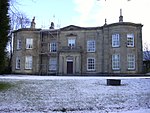A671 road
Geographic coordinate listsInfobox road instances in the United KingdomInfobox road maps tracking categoryLists of coordinatesRoads in England ... and 3 more
Roads in Greater ManchesterRoads in LancashireUse British English from February 2013

The A671 is a road in the North West of England, that runs between Oldham, Greater Manchester and Worston, near Clitheroe, Lancashire. Major towns on the route include Rochdale and Burnley. The road is approximately 35 miles (56 km) long. Between Burnley and the A59, the A671 has primary status. The section of road between Burnley and Whalley has been identified as one of the UK's ten most dangerous roads, with 48 serious or fatal collisions between 2000 and 2005.
Excerpt from the Wikipedia article A671 road (License: CC BY-SA 3.0, Authors, Images).A671 road
Burnley Road, Borough of Rossendale
Geographical coordinates (GPS) Address Nearby Places Show on map
Geographical coordinates (GPS)
| Latitude | Longitude |
|---|---|
| N 53.719 ° | E -2.1988 ° |
Address
Burnley Road
Burnley Road
OL13 8PQ Borough of Rossendale
England, United Kingdom
Open on Google Maps







